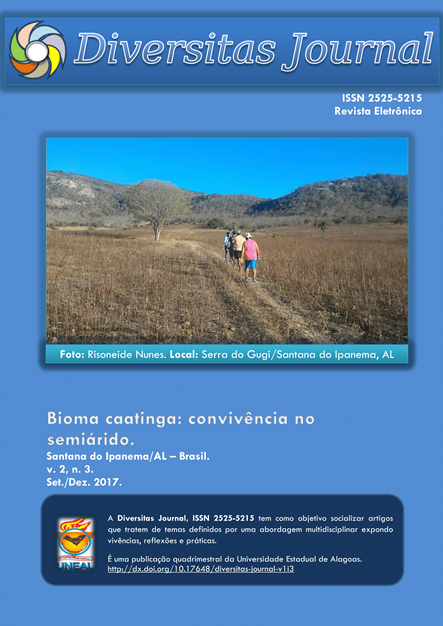Conteúdos de ensino em ciências: as pedras fundacionais na prática docente pelo ensino por investigação
DOI:
https://doi.org/10.17648/diversitas-journal-v2i3.513Abstract
RESUMO: Pesquisas como as feitas por Selbach (2010) mostram que os professores planejam suas aulas de ciências com a utilização de questionários com palavras de ordem imperativa: “Defina, conceitue, classifique”. Essa prática bastante recorrente nas aulas de ciências aponta a grande relevância dada, apenas, aos conteúdos conceituais nos planejamentos de ensino. Objetivou-se com este estudo divulgar o ensino de ciências por investigação como uma perspectiva de ensino que pode de forma eficaz orientar os professores a trabalhar além dos conteúdos conceituais, conteúdos procedimentais e atitudinais. O presente estudo foi fundamentado na abordagem qualitativa com enfoque na pesquisa bibliográfica. Nesses termos, eanalisamos uma sequência investigativa intitulada “De onde vem o arco-íris? no intuito de verificarmos nas ações didáticas desta como trabalhar de forma articulado conteúdos conceituais, procedimentais e atitudinais em planejamentos de aulas de ciências. Assim, foi verificado que o ensino de ciências por investigação por elucidar ações físicas, cognitivas e comportamentais dos alunos no processo de aprendizagem pode contribuir sobremaneira para esse objetivo.
PALAVRAS-CHAVE: formação docente; anos iniciais; ensino
ABSTRACT: Research such as those made by Selbach (2010) show that teachers in the early years planning their science classes with the use of questionnaires with words peremptory order: "Set, conceptualise, sort." This fairly standard practice in science classes shows the great importance given, only the conceptual content in educational planning. For this reason, we aim to disseminate education research in science as a teaching strategy that can effectively guide teachers to work beyond the conceptual content, procedural and attitudinal content. This study was based on a qualitative approach with a focus on literature. In these terms, we prepared an investigative sequence entitled "Where the rainbow come from? in order to analyze the didactic actions of this working articulated form conceptual, procedural and attitudinal content in science lesson plans. Thus, it was found that the educational research in science by elucidating physical, cognitive and behavioral actions of students in the learning process can contribute greatly to this goal.
KEYWORD: teacher training; early years; teaching.
Metrics
References
BARDIN, Laurence. Análise de conteúdo. São Paulo: Edições 70, 2011.
BRASIL. Secretaria de Educação Fundamental. Parâmetros Curriculares Nacionais:Ciências Naturais.Brasília, 1997.
CAMPOS, Maria Cristina da Cunha; NIGRO, Rogério Gonçalves. Didática de ciências. São Paulo: FTD, 1999.
CARVALHO, Anna Maria Pessoa de. Ensino de Ciências por investigação: condições para implementação em sala de aula.São Paulo: Cengage Learning, 2013.
NEVES, José Luis. Pesquisa Qualitativa: Características, usos e possiblidades. Disponível em: <http://www.dcoms.unisc.br/portal/upload/com_arquivo/pesquisa_qualitativa_caracteristicas_usos_e_possibilidades.pdf>. Acesso em: 10 jul. 2007.
POZO, Juan Ignacio; CRESPO, Miguel Ángel Gómez. A aprendizagem e o Ensino de Ciências: do conhecimento cotidiano ao conhecimento científico. 5.ed. Porto Alegre: Artmed, 2009.
SELBACH, Simone et al. Ciências e didática. Rio de Janeiro: Vozes, 2010. (Como bem ensinar).ZABALA, Antoni. A prática educativa: como ensinar. Porto Alegre: Artmed, 1998.
Downloads
Published
How to Cite
Issue
Section
License
Copyright (c) 2019 Liliane Oliveira de Brito

This work is licensed under a Creative Commons Attribution 4.0 International License.
The Diversitas Journal expresses that the articles are the sole responsibility of the Authors, who are familiar with Brazilian and international legislation.
Articles are peer-reviewed and care should be taken to warn of the possible incidence of plagiarism. However, plagiarism is an indisputable action by the authors.
The violation of copyright is a crime, provided for in article 184 of the Brazilian Penal Code: “Art. 184 Violating copyright and related rights: Penalty - detention, from 3 (three) months to 1 (one) year, or fine. § 1 If the violation consists of total or partial reproduction, for the purpose of direct or indirect profit, by any means or process, of intellectual work, interpretation, performance or phonogram, without the express authorization of the author, the performer, the producer , as the case may be, or whoever represents them: Penalty - imprisonment, from 2 (two) to 4 (four) years, and a fine. ”


















